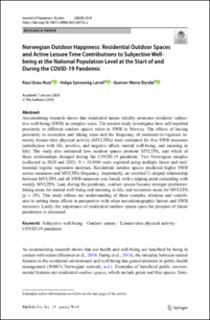| dc.description.abstract | Accumulating research shows that residential nature reliably promotes residents’ subjective well-being (SWB) in complex ways. The present study investigates how self-reported proximity to different outdoor spaces relate to SWB in Norway. The effects of having proximity to recreation and hiking areas and the frequency of moderate-to-vigorous intensity leisure-time physical activity (MVLTPA) were estimated for five SWB measures (satisfaction with life, positive, and negative affect, mental well-being, and meaning in life). The study also estimated how outdoor spaces promote MVLTPA, and which of these relationships changed during the COVID-19 pandemic. Two Norwegian samples (collected in 2020 and 2021; N = 34,904) were explored using multiple linear and multinomial logistic regression analyses. Residential outdoor spaces predicted higher SWB across measures and MVLTPA frequency. Importantly, an inverted U-shaped relationship between MVLTPA and all SWB measures was found, with a tipping point coinciding with weekly MVLTPA. Last, during the pandemic, outdoor spaces became stronger predictors: hiking areas for mental well-being and meaning in life; and recreation areas for MVLTPA (p < .05). This study refines our understanding of these complex relations and contributes to setting these effects in perspective with other sociodemographic factors and SWB measures. Lastly, the importance of residential outdoor spaces upon the prospect of future pandemics is discussed. | en_US |
